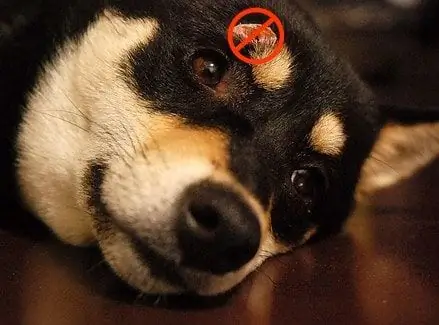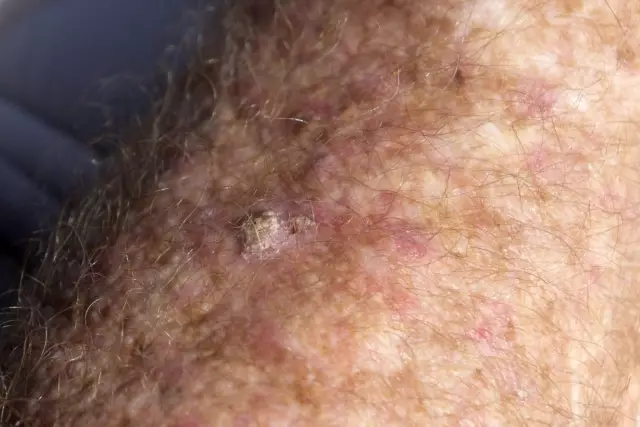
- Autor Daisy Haig [email protected].
- Public 2023-12-17 03:12.
- Ostatnio zmodyfikowany 2025-01-24 12:41.
Oba moje buldogi francuskie cierpiały na nieestetyczne, często swędzące i technicznie łagodne guzy, które nazywamy histiocytoma. Chociaż histiocytoma zazwyczaj ustępują po dwóch do trzech miesiącach, niepewność pochodzenia tego guza powoduje, że większość weterynarzy odcina go (lub przynajmniej część), aby zapewnić jego łagodność.
Chirurgiczne skalpelowanie „łagodnej” masy może wydawać się ekstremalne, ale ponieważ histiocytoma może być zarówno denerwująca, jak i przerażająca, często wskazana jest operacja.
Irytujące: ponieważ często pojawiają się na głowie i stopach, w miejscach, w których idealnie okrągłą, owrzodzoną masę można łatwo podrapać lub wylizać.
Przerażające: Ponieważ trudno powiedzieć, czy to, co właśnie pojawiło się na skórze twojego psa (i zwykle dzieje się to szybko), to paskudny guz komórek tucznych (lub jakaś inna taka masa potwora)… czy też jego łagodniejszy kuzyn, histiocytoma.
Przerażające: Ponieważ trudno powiedzieć, czy to, co właśnie pojawiło się na skórze twojego psa (i zwykle dzieje się to szybko), to paskudny guz komórek tucznych (lub jakaś inna taka masa potwora)… czy też jego łagodniejszy kuzyn, histiocytoma.
while young dogs (under three years of age) are more likely to get these, they can happen to dogs of any age. indeed, my older frenchie, sophie sue got one about a year ago. she was nine-not exactly a spring chicken. vincent has had three. and he’s not yet two years old.
some breeds are more predisposed. labrador retrievers and boxers, for example. though frenchies aren’t on the list, perhaps they should be… (perhaps they should be on the list for almost everything if my recent round of healthcare scares is any guide.)
ugly and prominently placed as they typically are, most owners want histiocytomas removed. some vets, however, will counsel owners to either wait a few weeks (especially if the dog is young and statistically less likely to be suffering from a malignant mass) or to have a simple section of it snipped (with a local anesthetic) for histopathological analysis at the pathology lab.
other vets will even take a needle poke at it, though most pathologists find that histiocytomas are not easily disgnosed definitively through this method (cytology).
if the dog is older or the mass is especially annoying to the dog or owner, however, we remove the whole sucker and clean up the mess quickly. unfortunately, though, this approach is more costly and usually requires general anesthesia. it’s nonetheless the approach i take for more than half of these tumors…better to be safe than sorry, right?
still, most owners need to know they have a choice. the nervous nellies among you (like me) are less likely to want to stare at a mass for a couple of months to see if it simply goes away. the rational or more anesthetically cautious, however, are justified in waiting-as long as their dog is young and/or hasn’t suffered from malignant masses in the past.
whatever choice you make, consider histiocytomas an excellent foray into the world of skin tumors. it’s like a warm-up for what’s likely to come as your dog ages. and it’s not all bad. look on the bright side: curing cancer is sometimes just a scalpel slice away.
Zalecana:
Hemangiosarcoma Lub łagodny Guz – Leczenie Swojego Zwierzaka Z Powodu Guzów Nowotworowych

Kiedy nie ma możliwości dowiedzenia się, czy guz twojego zwierzaka jest łagodny czy złośliwy, w jaki sposób decydujesz, czy zezwolić na leczenie guza?
Guz Tkanki Tłuszczowej (łagodny) U Kotów

Naciekający tłuszczak to inwazyjny, łagodny nowotwór złożony z tkanki tłuszczowej, wariant, który nie daje przerzutów (rozprzestrzenia się), ale który jest znany z naciekania tkanek miękkich, zwłaszcza mięśni, ale także powięzi (składnik tkanki miękkiej tkanki łącznej układu tkankowego), ścięgna, nerwy, naczynia krwionośne, gruczoły ślinowe, węzły chłonne, torebki stawowe, a czasami kości
Guz Tkanki Tłuszczowej (łagodny) U Psów

Naciekający tłuszczak jest odmianą nowotworu, który nie daje przerzutów (rozprzestrzenia się), ale wiadomo, że nacieka tkanki miękkie, zwłaszcza mięśnie. Jest inwazyjnym, łagodnym nowotworem zbudowanym z tkanki tłuszczowej i choć znany jest głównie z penetracji do tkanki mięśniowej, powszechnie występuje również w powięzi (składnik tkanek miękkich układu tkanki łącznej), ścięgnach, nerwach, krwi naczynia, gruczoły ślinowe, węzły chłonne, torebki stawowe, a czasami kości
Guz Skóry (Histiocytoma) U Psów

Histiocytoma to łagodny nowotwór skóry wywodzący się z komórek Langerhansa, komórek odpornościowych, których zadaniem jest zapewnienie ochronnej odporności tkankom, które mają kontakt ze środowiskiem zewnętrznym
Guz Skóry (Histiocytoma) U Kotów

Komórki Langerhansa to komórki odpornościowe, których zadaniem jest zapewnienie ochronnej odporności tkankom, które mają kontakt ze środowiskiem zewnętrznym – nos, żołądek, jelita i płuca, ale głównie powierzchnię skóry. Komórki te są również nazywane komórkami dendrytycznymi i histiocytami. Histiocytoma to łagodny nowotwór skóry wywodzący się z komórek Langerhansa
